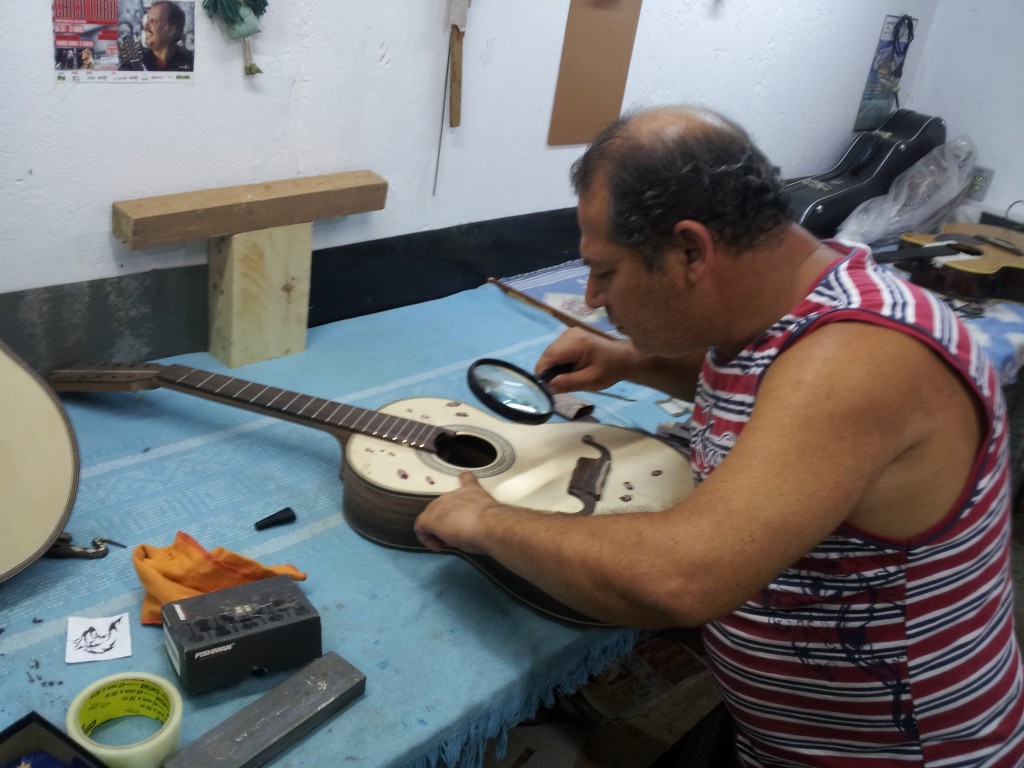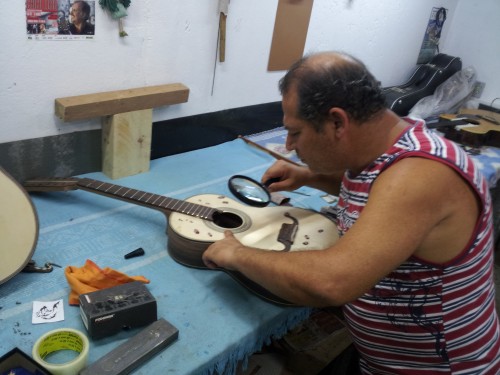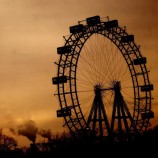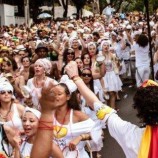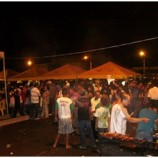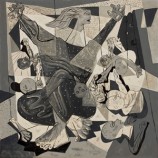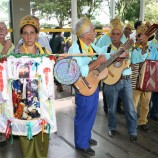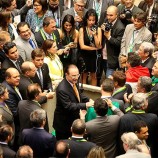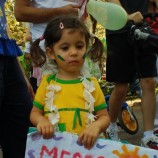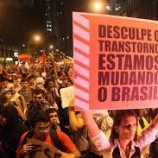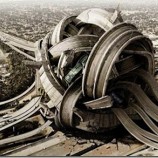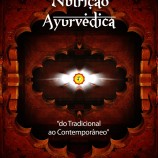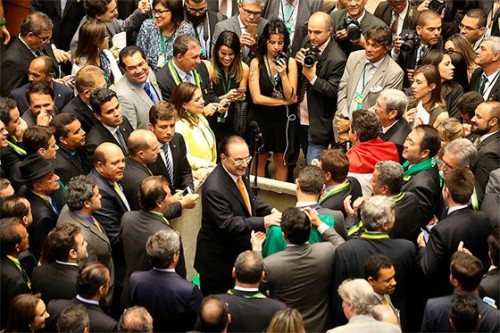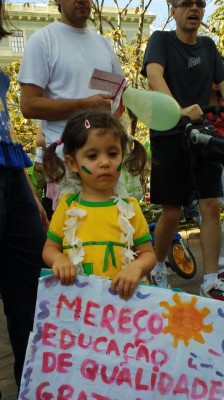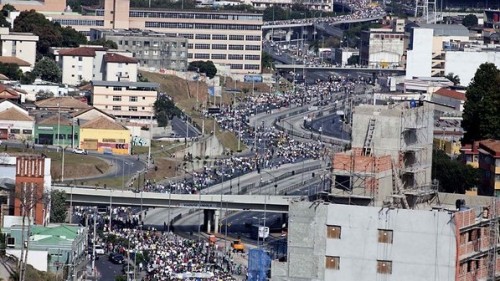Preferring to be called an artisan of stringed instruments rather than a “luthier”, a term he considers to be too serious for him, for having been one of the discovering pioneers of the art, Roberto Dimathus builds the 12 string viola caipira (Brazillian rustic guitar), guitars, cavacos (Brazillian ukalele) and bandolins. Born in the town of Linhares, the state of Espírito Santo, today he resides in the district of Justinópolis, County of Ribeirão das Neves, near Belo Horizonte, Minas Gerais, a state considered to be a wine cellar of great artists. He has built instruments for musicians such as Renato Andrade, Pena Branca, Chico Lobo, Daniela Lasalvia, Zé Helder, Marcus Biancardini, Noel Andrade. As an instrumentalist he has accompanied the careers of Renato Andrade, Chico Lobo, Pereira da Viola e Marcus Biancardini, creating basis on the guitar to go together with the viola caipira.
How did your interest begin in this craft?
Ever since I was a kid I’ve felt something special for wood, I come from a family of carpenters. Whenever I set my eyes on a musical instrument I just felt something good which I couldn’t rightly understand. As I grew up and started getting involved with music and building instruments, a peace began to sway inside of me. I would look at an instrument like a viola caipira and began to cry. That’s just how it happened. I am a capixaba (native of Espírito Santo State), a hopeless romantic. I came to Minas in ’82, started playing for myself and observing other people. I cannot say that I am self-taught because from the moment that you watch someone and learn something from that person, you cannot consider yourself self-taught anymore, that person has become your teacher. When I came to Belo Horizonte I met Renato Andrade, and then after got in touch with Chico Lobo, Pereira da Viola, so these people essentially showed me the world of the viola caipira. In fact, who really grasped viola caipira more than anyone else was Renato Andrade, the others showed up afterwards and we would pass things on to them.
How was your first contact with Renato Andrade? How did this relationship evolve? What are some good memories that you have of him?
I saw him play at the Universidade Católica, currently PUC, in Belo Horizonte. I saw that beautiful instrument and went in for a closer look. I had seen the Tonante e Reis violas before which they played as a double performance, but the viola caipira that Renato was playing on that theater stage was a different, more classical viola caipira. I was enthralled. I walked over to talk to him and told him that I also played the viola caipira. At that very moment, a friendship was born. He gave me his address and we started playing together. We traveled around and I got to know the true sound of the viola caipira. We recorded two albums together: in 1984 “O Violeiro e o Grande Sertão”, and in 2004 “Viola no Saco”, his last work. We travelled a lot playing viola caipira and with me playing supporting guitar. We played together for many years, at the Palácio das Artes in Belo Horizonte, in the interior of Minas and other capital cities like Brasília, São Paulo and Curitiba.
We all know that Espírito Santo is a state very well known for its rich cultural manifestations. Are there any in your hometown of Linhares?
There’s the Congo group, but it’s more of a religious thing. At that time I was more of a Rock and Roll man, I liked Elvis Presley. But I always had a Tonico and Tinoco viola caipira hanging above my bedpost because the people at home woke up early to go to work listening to groups like: Zé Betio, Mococa e Mola Fria, Tião Carreiro and Pardinho, mostly of which were duet singers of sertaneja, (Brazillian country). I listened to a lot of them. When I arrived in Belo Horizonte it was incredible to have met Renato, I could hear the true country viola.
What source of wood do you use for your work?
Today there isn’t any real source. We go out looking here and there. Where I lived when I was a kid the Atlantic rainforest was still around. It still is, but it’s very “protected” by the company Vale do Rio Doce. In my days, wood was used for building a house, wood was used to make a bridge, to make a piece of furniture. Today, since it’s my home town, I always know where to find little logs left in the middle of the coffee plantations. I never cut down a tree, and I don’t intent to. When a tree’s time comes, the wind blows it down because it’s old. Also from house demolitions, always logs and smaller pieces. It is a difficulty to find. It’s not like it was in the old days. Nowadays they stick a branch of wood into a machine and on the other end a toothpick comes out. Traditionally, ours is Jacarandá, very difficult to find. You can still find a little Ceder, but it’s like a miner’s job, what gold diggers do in riverbeds is like what we are doing today with wood.
Do you have any projects in sight as an instrumentalist and artisan?
Yes I do! In ’82 I came to Minas to study music and be a singer. But things got tough and I changed direction. The project, which goes back many years now, is to make a CD and a documentary. A CD with songs from friends that I met here on the road, the Mineiros, and they have really good stuff! I say that this place is chock full of talent, thank God! So from this gang here I’ve been able to salvage a lot. I have songs by Paulinho Amorim , Rubinho do Vale, Chico Lobo. I’m going to put together what suits me and record 13 tracks on this disk and then put in a little book of memories and photography.
You’re currently living in a borrowed home and now you have a property across the street and are trying to build a new workplace and home. What is your new workshop going to be like?
In the future, I intend to launch a more affordable instrument. The space I’m working in now is very small. There I will have more storage space. It is very interesting to make a top of the line viola caipira and a cheaper guitar. I will have my own showroom along with my house.
What kind of advertisement do you have for your work?
It’s been word of mouth. I get to know musicians and one tells the next. I haven’t invested in advertising as of yet.
What’s your contact info?
It’s basically my telephone which is: 31-3638-6347. Through this contact I give directions here. Generally I always have a viola caipira for show. Every once in a while I play guitar but what I really like is the viola caipira, I have fallen in love with it too. Here we always try to make good stuff. I stay here, God and I, I and God, sonny, and we go around researching wood, which is very difficult to find, I don’t know how it’s going to be a little farther down the road.
Related Articles


